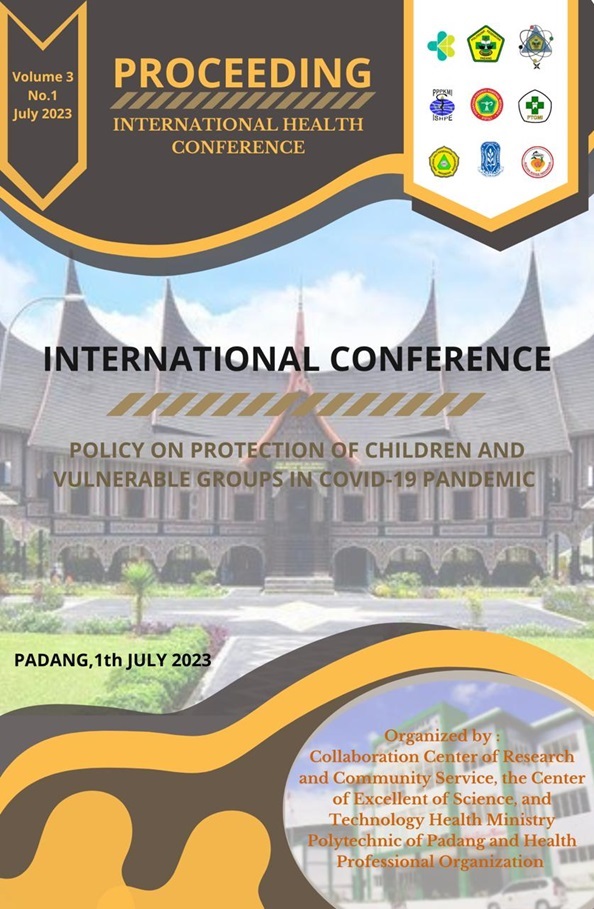Analysis of Compliance with DM Management During the Covid-19 Period at the Solok City Health Center
Abstract
Based on the 2018 Basic Health Research (RISKESDAS), one of the PTM whose prevalence has increased significantly is diabetes mellitus reaching 8.5%. prevalence in West Sumatra was 13,834, while the City of Solok was 1,796 in 2018. Diabetes mellitus can increase the risk of death in Covid-19 patients. The purpose of this study was to determine the compliance of Type-II DM patients in the management of the five pillars of DM (diet, taking medication, physical activity, education, and blood sugar control. This study used a descriptive-analytic cross sectional approach. The population was type 2 DM patients who visited the posbindu). The last 3 months amounted to 65 people.The results showed that adherence to medication, diet, education, and blood sugar control had a significant relationship with blood sugar levels with p value = <0.05. it turns out that the most dominant relationship with blood sugar levels is the regularity of taking medication with (p value 0.002) OR = 72.500. It is hoped that people who suffer from diabetes mellitus can understand the importance of implementing DM management. There is a policy from the Health Office involving family members to care so that the five pillars of DM management can be implemented properly so that DM patients can lead a life without complications.
Downloads
References
Riskesdas. (2018).Hasil Utama Riset Kesehatan Dasar.(Kementrian Kesehatan Republik Indonesia
Kemenkes. (2020). Info Datin.
WHO. (2016). Global report on diabetes, International Jurnal Of Noncomunicable Disesses. 01,3–8
Association, A. D. (2018).Diagnosis And classification of diabetes mellitus, Care. 27, 55-60
Kemenkes. (2019). Laporan Provinsi Sumatra Barat Riskesdas 2018. Balitbangkes
Kesehatan Kota Solok, (2019). D. Rekapitulasi Laporan Program Posbindu PTM Perkeni. Pernyataan Resmi dan Rekomendasi Penanganan Diabetes Melitus di Era Pandemi Covid-19. (IDI, 2020).
Potter, P. A. & Perry, A. G.(2010).Fundamentals Keperawatan Buku 1 Edisi 7. Elsevier
Fandinata, S. S. & L. E. Managemen Terapi Pada Penyakit Degeneratif. (Graniti, 2020).
Ward Jeremy P.T, Ward Jane, Leach Richard, & W. C. M. (2016). Sistem Endokrin. Erlangga
Firdiawan,A.(2020). Kepatuhan Pengobatan Pasien Diabetes Mellitus Tipe 2 dengan Medication Adherence Rating Scale. J. Farmastis9, 65–75
S, Y. (2016). Paradigma Shifts in Nutrition Therapy for Type 2 Diabetes. Keio J Med 33–43
Rahayu KB, Saraswati LD, S. H. (2018). Fator-faktor yang berhubungan dengan kadar gula darah pada penderita diabetes mellitus tipe 2. J. Undip6, 19–28
Febrianti, D., Thaha, R.M.,& Hidayanti, H. (2020). Pola Makan Pasien Rawat Jalan DM Tipe- II di Rumah Sakit Pendidikan Unhas. Kesehat. Masy. Marit.3, 44–56
Nanda, O.D.,Wiryanto, R.B., & Triyono, E.(2018).Hubungan kepatuhan Minum Obat Antibiotik dengan Regulasi Gula darah pada pasien diabetes melitus Releationship between Antidiabetik Drugs Consumption and Blood GlucoseLevel regulation for Diabetes mellitus Female Patients. 340–348
Lemone, P., M. Burke, K. & Bauldoff, G. (2015). Buku Ajar Keperawatan Medikal Bedah. EGC
Srikartika, V. M., Cahya, A. D. & Hardiati, R. S. W. (2016). Analisis Faktor yang Memengaruhi Kepatuhan Penggunaan Obat Pasien Diabetes Melitus Tipe 2. 6, 205–212










